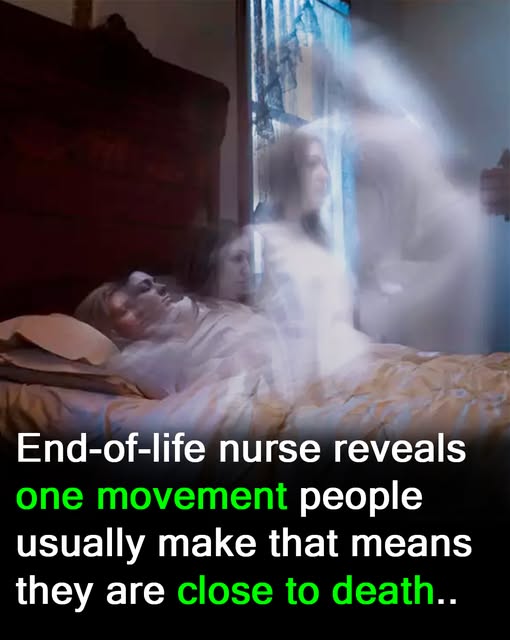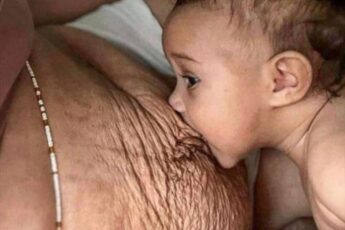Working in end-of-life care is not something that can be easily described to those who haven’t lived it. It’s a space where sorrow and tenderness intertwine every single day, where grief sits heavy in the air but moments of quiet wonder often break through like shafts of sunlight through storm clouds. For many caregivers, these small, unexplainable moments become as unforgettable as the sadness itself. One hospice nurse in particular, Katie Duncan, has shed light on one such experience she has witnessed countless times throughout her career: a simple, mysterious gesture many patients make just before taking their last breath.
Katie is not just any nurse. She is a nurse practitioner and what she calls a “death care coach,” working in Maryland, and she has spent years guiding patients and families through the most difficult chapter of life. Her career has taken her into the sterile halls of intensive care units, into the quiet bedrooms of home hospices, and into long-term care facilities where time moves slowly, but loss still arrives with the same finality. Across all of these settings, Katie has observed a striking pattern. As life fades, many patients begin to reach upward, lifting their hands or arms toward something invisible above them, as though stretching for someone who isn’t physically there.
In a recent TikTok video that drew enormous attention, Katie explained what she has come to see as one of the “mystical” parts of dying. “In my experience, it’s very common,” she shared, her voice calm but reverent. “You’ll literally see someone reach up, like they’re trying to hold someone’s hand or touch something in the air.”

This gesture, she noted, isn’t always a random reflex. Sometimes, it’s accompanied by what caregivers know as end-of-life visions. These visions are not hallucinations in the medical sense, nor are they generally distressing. Instead, they seem to bring profound peace. “People often say they’re seeing someone — a loved one who passed before them, a pet they adored, even an angel or a bright light,” Katie explained. “Other times, they don’t speak at all, but their hands rise as though they’re sensing a presence.”
Imagine sitting at the bedside of a loved one who has been weak for days, unable to even lift a glass of water, and suddenly you see them stretch their arms upward with a kind of strength you thought was gone. For many families, the sight is both startling and comforting. It suggests that the boundary between this life and the next might be thinner than we realize. Katie has witnessed this countless times, and while there is no scientific explanation, she sees it as a sacred mystery that speaks to something greater than what medicine alone can measure.
What struck her most in these moments, she added, is that patients rarely look afraid. If anything, they appear comforted. “These visions, whatever their origin, often bring people a deep sense of calm,” she said. “It’s one of the more mysterious aspects of death that we’re lucky enough to witness as caregivers. It’s humbling.”
Her words resonated far beyond the walls of the hospice. Online, Katie’s video sparked a flood of responses from people who had been present when their loved ones passed away. One commenter wrote, “My dad reached up with both arms. Before that, he hadn’t been able to lift them at all. It was like someone was calling to him.” Another person added softly, “It’s the in-between. What a privilege to witness.”
Others shared their interpretations. “It’s heaven they’re reaching for,” one person wrote, as if stating a truth they had always known. Another recalled, “I didn’t want to disturb him. It felt sacred, like I was watching something private between him and God.”
Stories like these show how universal the experience is. Across cultures, religions, and even among those with no strong spiritual beliefs, families often describe eerily similar final gestures. A grandmother who opens her arms wide as though greeting someone unseen. A child whispering the name of a parent who died years earlier. A man smiling faintly at a corner of the room no one else can see. Even skeptics find themselves at a loss for words when they witness it firsthand.
For caregivers, these moments serve as a gentle reminder that their work is not only medical but deeply human. Yes, there are medications to ease pain, protocols to follow, and endless details to manage. But there are also moments that cannot be charted or quantified — moments that remind them of the mystery of existence and the beauty of transition. Katie sees herself not only as a medical professional but as a companion on the journey, someone privileged to witness the sacredness of departure.
Families, too, often find comfort in these gestures long after their grief sets in. The image of a mother stretching her hands upward, smiling faintly as though greeting someone beloved, can transform how her children remember her passing. Instead of a moment defined by loss, it becomes one colored with hope, suggesting she was not leaving into emptiness but into reunion.
While science has yet to explain why these upward-reaching motions occur — whether they are neurological, psychological, or spiritual — many in palliative care agree they should not be dismissed. They are a natural part of the dying process, one that seems to provide reassurance not just to patients but to the loved ones who remain.
Katie herself sums it up best: “Death is not just the end of something. It’s also the beginning of something we can’t quite understand. And sometimes, we’re lucky enough to catch a glimpse of it in those reaching hands.”
Her reflections continue to ripple outward, offering comfort to strangers who may one day sit beside a hospital bed, holding the hand of someone they love, and watch as their fingers slowly rise into the air. In that moment, they may remember Katie’s words and feel less afraid, knowing their loved one’s final gesture might be one of peace, of connection, and of quiet wonder.
For all its heartbreak, end-of-life care carries moments like these — small, mysterious blessings that remind us that even in our final moments, we are never entirely alone.






